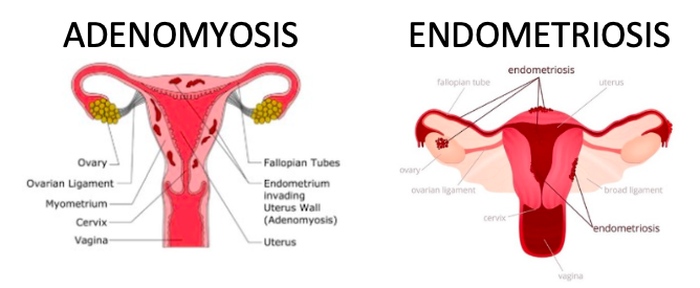Adenomyosis & Endometriosis
Adenomyosis presents with very similar symptoms as endometriosis. It is possible to have both conditions at the same time. Here is a closer at look at adenomyosis and how the treatment is often similar to that being offered for endometriosis.

Adenomyosis is where the cells from the lining of your womb are found in the muscle wall of the uterus. This makes the uterine walls grow thicker. It may lead to heavy or longer-than-usual menstrual bleeding, as well as pain during your menstrual cycle or intercourse.
Adenomyosis can occur in any woman who is still having periods, and naturally stops after menopause. It is estimated around 1 in 10 women are affected by adenomyosis, yet many of them don't know it - because a third of them won't have any symptoms.
There are many similarities between adenomyosis and other uterine problems
There are other diseases of the uterus which many women can have which causes the symptoms that are similar to adenomyosis thus making adenomyosis much more problematic to diagnose. Some of these conditions include uterine cell growth outside the uterus in other areas of the pelvic cavity (endometriosis), fibroid tumours, as well as growths in the lining of the uterus (endometrial polyps).
There are several theories about the cause of adenomyosis
These include:
- Extra tissues in the uterine wall, present before birth, that grow during adulthood
- Invasive growth of abnormal tissues (called adenomyoma) from endometrial cells pushing themselves into the uterine muscle — this may be due to an incision made in the uterus during surgery (such as during a cesarean delivery) or during normal uterine functioning
- Uterine inflammation that occurs after childbirth — this may break the usual boundaries of the cells that line the uterus
The symptoms of adenomyosis can be severe
he two most prevalent symptoms of adenomyosis are heavy, painful periods that become irregular, or last for a long time, and significant pelvic pain and discomfort even when you’re not on your period.
Some sufferers also report having pain during sex, or when going to the toilet. However, these symptoms aren't exclusive to adenomyosis, which can make it tricky to diagnose, or identify individually.
The most common symptoms are:
- prolonged menstrual cramps
- spotting between periods
- heavy menstrual bleeding
- longer menstrual cycles than normal
- blood clots during menstrual bleeding
- pain during sex
- tenderness in the abdominal area
Diagnosis of adenomyosis
Your doctor will first do a physical examination which can often show an enlarged uterus which can often be double the normal size.
Ultrasound is also used in diagnosis which uses sound waves to capture moving images of the abdomen. Ultrasounds can show islands of cysts within the uterine muscle, showing adenomyosis. Many specialists will also advise an MRI, which is the best way to diagnose adenomyosis.
Definitive diagnosis, as with endometriosis, is with tissue biopsy. This is performed by use of laparoscopy surgery where the surgeon can visible inspect the abdominal cavity.
Difference between endometriosis and adenomyosis
In endometriosis, endometrial-like tissue grows on organs outside of the uterus. In adenomyosis, the actual endometrial lining grows into the uterine muscle, damaging the uterine wall. The two are often confused because they can occur simultaneously and they mimic the same symptoms. While it is possible to have both at the same time, it is also possible to have adenomyosis without endometriosis.
Treatment of adenomyosis
Drug treatment:
Many of the drugs used for women with endometriosis are also used to treat adenomyosis, but it is important to note that not every woman is the same and can suffer from side effects. Birth control pills are often used to help control the pain and bleeding. Anti-inflammatory drugs such as motril are often used as well as other medications to manage the pain.
Surgery:
Excision surgery is commonly performed with a laparoscopy procedure. Using this precise technique, a surgeon is able to view and remove any harmfully growing tissue within the uterus, therefore relieving adenomyosis symptoms, while keeping the uterus intact.
Hysterectomy or partial hysterectomy is another surgical treatment - This is a surgical technique in which the uterus or part of the uterus is removed. It should be performed with caution and only in cases of severe adenomyosis.
Reference:
https://www.webmd.com/women/endometriosis/women-endometriosis-vs-adenomyosis#1
http://centerforendo.com/adenomyosis-is-it-really-endometriosis
https://en.wikipedia.org/wiki/Adenomyosis
 As featured in:
As featured in:




